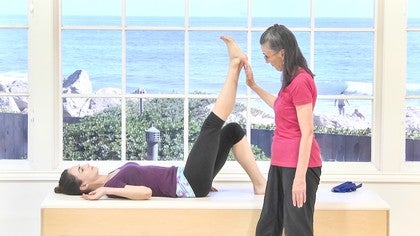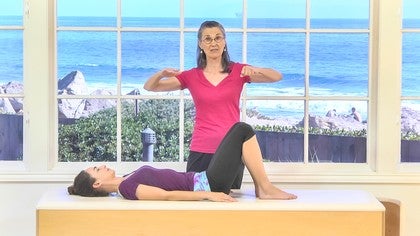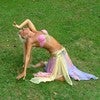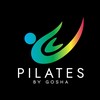Description
About This Video
Transcript
Read Full Transcript
Okay. I wanted to explain something to you and to everyone about Eve gentry and the way she's breath. That was one of the things that she did change of polities. Um, when I originally began studying with her, you inhaled on effort, for instance, on reformer footwork, you would inhale as you pressed out, she began to change that because the client she was getting were injured. And when they would do any reformer work as they inhale and pushed out their backs and spasm and then you suddenly see this,
So we'll just do it that way. So just lie down with your head in that direction and bend your knees and put your feet flat. Now, the other thing that she did for her injured twice is she would take one of the half barrels and she'd put their legs over the, I think it's called spine, correct or no, and then if they were cold, we had blankets and we had pillows. I mean it was quite luscious. Right? But in any event, what you want to do is you just want to do deep diaphragmatic breathing. You want to inhale through your nose and exhale, gently blowing out as if you could bend the flame of a candle. Okay. We'll just go. Yeah, and she would say, just let your belly expand as you inhale.
Don't worry about keeping your belly,
We'll get there in a moment. The next breath that she began to work on was what you call breastbone breathing. And so you would imagine that you're a book and the center of your sternum is the spine of the book, right? And as you inhale, you open the book, what was breaking the spine like you do when some cheap paperback novels. And as you exhale, you close the book. So both sides of the chest just came together.
That's breastbone breathing. It's to get moot motion through the rib cage in the forward, backward direction.
Inhale, think of pressing the arms of gently into the mat. Exhale and bring the elbows together across your chest. Inhale open and exhale and bring your elbows together, Athens, and inhale open and exhale. So you add some assistance here in getting this breath done. Yeah. Nice.
Now I'm going to have you sit up and show away where you learned to breathe into the full rib cage, all the way around, which is more efficient for movement. So just sit, let, let's let people look at your back a little bit. So put your knees on this side and you're just going to take a theraband. You can let your legs fall off. And I was comfortable. You're going to place it around here and hold onto it with your hands and straighten your arms up towards the window.
So you're just around the bottom of the ribs. Right? And as you inhale, you want to feel the bottom of those ribs expand to the back and out to the side. Yeah. So now you're working in a more circular fashion through the rib cage, right in a breath pattern that's more functional for [inaudible] or for any work because you can keep your abdominals in and the breath is coming directly up into the rib cage. So you have basic relaxation breathing. You can bend this, which is belly breath. More forward in the belly.
So you're right up here in the thoracic spine. That's it. Trying to mobilize the thoracic spine in a forward, backwards direction. He was a great mobilizer. And then a more stabilizing breath, which we can call them at appropriate breath for exercise, right? Which helps if you have this, straighten your arms towards the window and then you can feel your ribs move right side sidewards and backwards. Yeah, take your hand and close off your opposite nostril with your finger.
Good. So now you breathe into your left lung. I'll try to do it with the air, not with the muscles. Does that make sense? So breathe into my hand.
So now you have to breathe in here. Try not to d c, don't do it with your muscles. Does that make sense? Really try and fill your lungs with air. That's it. Air is very, very powerful. We float all kinds of things up into the sky with hot air and air.
You Go, yes. One lung breathing. Okay, now just let go. We're going to do a little test. Okay. You're going to turn and look over your right shoulder and just spot something over there. Good. Come back. Now you're going to turn and look over your right shoulder.
As you breathe into your right lung. You can keep your hand down one that was just to give you a sense, right? You don't need to put it up there once you've learned. Okay? So inhale into your right lung as you rotate [inaudible] a little further, Huh? And come back. Now.
Inhale into your left lung as you rotate to your right. So inhale into my hand as you rotate to your right
As you rotate to the right
Cause they're hollow side is collapsed. They need to breathe into that hollow side regardless of which way the rotating. Okay. To get that space up. But for other people it all depends. Some people like to be led around and other people sort of like to be pushed around. I don't know it, there isn't a right or wrong way.
It's a preference, but it's so helpful in rotation, which is so difficult really for a lot of people. So now let's look at the one lung breathing in terms of side bending. So you can just turn around and face front again and all you're gonna do is just breathe normally and just bend over side to side, bend over and come back over and bend the other side. So you actually can almost go to your elbow or whatever. You can put your hands out there you go.
And then come over here and bend to this way. So you just get your normal bend. Good. Now go over to your right as you come back through the center, inhale into your left lung and go left. Exhale, inhale and do your right lung. Anyone, we can even see the difference, right? And over. Inhale into your left lung and [inaudible].
Inhale into your right lung top lung. So gives you some buoyancy that if you don't do that, if you just go back to the regular bending, you have the same range, but you don't have quite that support in making the change. Yeah, it's nice. So just to make a quick re recap, we've got basic relaxation, breathing, belly breathing, I guess you could call it breastbone breathing. Four forward, backwards articulation, the full breath breathing theraband helps to breathe into back of the lungs. One long breathing, good for people with scoliosis.
Also for rotation to assist in rotation and to assist in the transfer side. Decide inside bending. She did one more breath pattern but she called threshold breathing. Threshold breathing is when you see a m in the movement pattern that there is a restriction that the individual is trying to push through or you're trying to push through and that restriction causes you to go out of alignment or you go and you wince cause there's pain and she developed it because of the pain issue of it. Right for you. We're going to do more for the restriction in it. Okay.
So I think it was this leg, bend this knee up to your chest all the way. Bend your left knee so your foot's just standing on the mat now just straighten this leg and don't worry about it all the way up to the ceiling. And then, yeah, we don't see it quite so much now because you're a little looser, right? Straighten up until you're almost straight to there. Right to there. And now come back down. [inaudible] so move your hand a little bit out of the way. See if they can see.
So as you come up, you begin to see this grab up. She gets better and better. She does it. Do it badly, right? And hold on a minute. Right? So what's your going to do? Because the thing is you want to always feel that your femur drops down into your pelvis even though you're straightening your leg up to the ceiling. Okay? So what you want to do for you, you want to on an inhale, just stay here. Exhale and stop. Inhale, stay here.
Exhale, feel that this is dropping and straighten that. Like there you go. Yes. And inhale and fold. And did you feel that difference now? Number one, you weren't trying to get it quite so perpendicular, which is fine. And again, so going up to rides where you begin to want to start to change to have a little pause and then go a little further into straighten on the next exhale. Yeah. And come down. Yeah.
Did you feel the difference? Yeah. And relax. You'll really feel people with their shoulders. You know, if you see somebody or you yourself, they go to here and everything's fine. And then boom, right there off to the side, cause they have some sort of shoulder. So you just go to here and right about you stop, right when they start to move you say inhale again and exhale and somehow they can get through that. I see. I don't know why I keep my mouth shut about my suspicions.
Okay. But that was threshold breathing. So for eve there were those really important breath patterns. Basic relaxation, breathing for pain relief, falling asleep, breastbone breathing for thoracic mobility. One lung breathing for thoracic mobility. Breastbone breathing by the way, would help you roll your head up off the floor. Let's go back. Put your hands behind your head so your head's just out of the picture. You let your arms support it.
Inhale and let your whole chest expand. Exhale, start to soften your chest and halfway through. Keep coming up and exhaling. There you go. All Right, nice. Huh. So you inhale, this can expand as you exhale halfway through this softens. There you go. The head can stay dropped into the hands. There you go. Yeah, a nicer isn't it? I mean to try and keep this up and roll forward.
There's a little bit of a contradiction in terms. So breastbone breathing for your forward flection. Also just for mobility in the chest, forward and back. One lung breathing for lateral rotation and rotation, lateral bending and rotation. The palabra is breath of the more functional breath where you three 60 trying to breathe helps with the theraband cause then they can feel it.
And threshold breathing, which is the one where you get to the threshold of the discomfort or the dysfunction. You take another inhale and you exhale and you go a little bit further. So Eve did change the breath pattern in Pilatos and so she began to exhale well on effort for people who had back injuries. Okay. So that when they would push out, say in the footwork, they would do so on an exhale so their backs wouldn't spasm and they'd r-chop off the floor. So that was a big change.
Pilates Legacy Project - Playlist 8: Eve Gentry Methods
Comments
You need to be a subscriber to post a comment.
Please Log In or Create an Account to start your free trial.






















